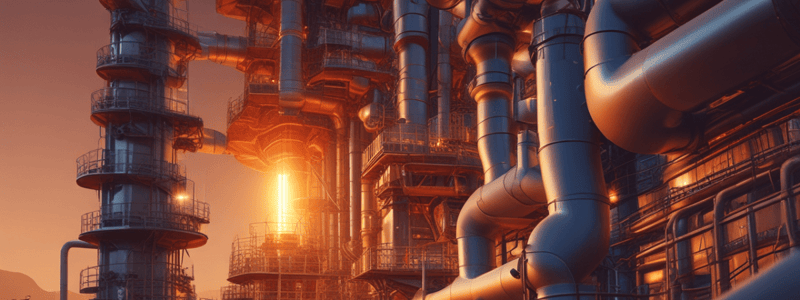Podcast
Questions and Answers
Thermal EOR Methods include cyclic steam injection, steam flooding, steam assisted [gravity] drainage (SAGD), in-situ combustion, and electrical heating.
Thermal EOR Methods include cyclic steam injection, steam flooding, steam assisted [gravity] drainage (SAGD), in-situ combustion, and electrical heating.
What are the five thermal EOR methods mentioned in the text?
What are the five thermal EOR methods mentioned in the text?
The five thermal EOR methods mentioned in the text are cyclic steam injection, steam flooding, steam-assisted gravity drainage (SAGD), in-situ combustion, and electrical heating.
In-Situ combustion is a thermal recovery process that involves igniting the oil in place to create a fire front that moves through the reservoir, reducing the viscosity of the oil and improving [mobility].
In-Situ combustion is a thermal recovery process that involves igniting the oil in place to create a fire front that moves through the reservoir, reducing the viscosity of the oil and improving [mobility].
What is the main oil recovery mechanism involved in in-situ combustion?
What is the main oil recovery mechanism involved in in-situ combustion?
What is the gas displacement process discussed in Chapter 5?
What is the gas displacement process discussed in Chapter 5?
Gas displacement processes involve injecting gas, such as natural gas or carbon dioxide, into the reservoir to [displace] the oil and force it towards production wells.
Gas displacement processes involve injecting gas, such as natural gas or carbon dioxide, into the reservoir to [displace] the oil and force it towards production wells.
What is the definition of EOR and what are the basic principles behind it?
What is the definition of EOR and what are the basic principles behind it?
Why is EOR becoming increasingly important in the oil industry?
Why is EOR becoming increasingly important in the oil industry?
What are some of the key parameters for IOR and EOR, and what are some of the techniques used for IOR?
What are some of the key parameters for IOR and EOR, and what are some of the techniques used for IOR?
What is the primary reason for the need of EOR?
What is the primary reason for the need of EOR?
What is the difference between IOR and EOR?
What is the difference between IOR and EOR?
What is the primary mechanism for improving sweep efficiency in EOR?
What is the primary mechanism for improving sweep efficiency in EOR?
What is the main reason for the implementation of Enhanced Oil Recovery (EOR)?
What is the main reason for the implementation of Enhanced Oil Recovery (EOR)?
Which of the following is NOT a method of Enhanced Oil Recovery (EOR)?
Which of the following is NOT a method of Enhanced Oil Recovery (EOR)?
What is the action on sweep efficiency at the microscopic scale in Enhanced Oil Recovery (EOR)?
What is the action on sweep efficiency at the microscopic scale in Enhanced Oil Recovery (EOR)?
Flashcards are hidden until you start studying
Study Notes
Studying That Suits You
Use AI to generate personalized quizzes and flashcards to suit your learning preferences.




